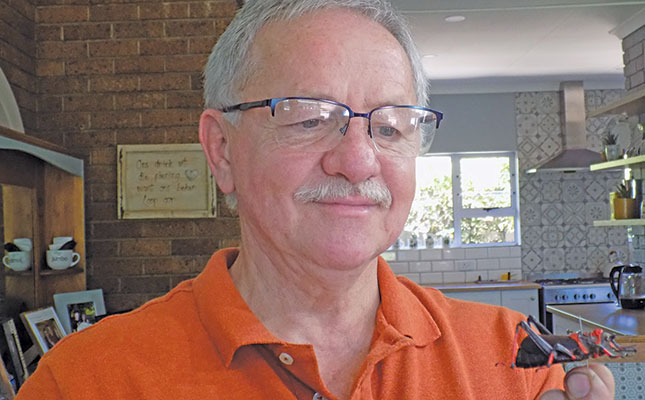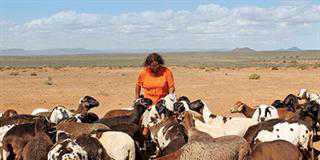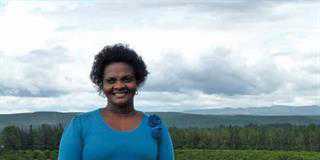
Photo: Annelie Coleman
Prof Johnny van den Berg has for many years been running ‘Bug Buddies’, his fun and highly interactive lessons aimed at teaching children about biodiversity from an early age. While these are currently limited to nursery schools in Potchefstroom and the surrounding areas, he would like to expand them to more schools to create increased awareness of biodiversity and the importance of insects in the world.
Van den Berg, a professor of entomology in the Department of Zoology at North- West University, has a particular passion for sharing his love of insects with children.
A Bug Buddies lesson is about an hour long, and carefully structured to hold children’s attention. Van den Berg and his university students usually set up four or five display stations with drawers containing big and small preserved insect specimens before the class starts.
The lesson kicks off with a lecture on ‘good’ and ‘bad’ insects, and why all insects are important for the environment. The class is then divided into small groups to visit each of the stations where Van den Berg’s university students discuss the insects in the collection with them.
“The children’s enthusiasm is irresistible and we usually have to field many questions that come thick and fast,” he says.
“My general impression is that the young ones are more scared of bigger bugs. However, it seems that certain insects, such as bees and wasps, are etched into their minds as ‘bad bugs’. I use Bug Buddies to tell them that while bees may sting you, they do not like to do it, and that they are important because they visit flowers, pollinate them and make honey.”
The Madagascar hissing cockroach is invariably one of the favourite insects used in his classes. Native to the island of Madagascar, it is commonly found in rotting logs, and can be up to 10mm long.
‘Good’ and ‘bad’ insects
The main objective of Bug Buddies days, explains Van den Berg, is to teach children that without insects, life on earth could not exist, as insects are crucial to sustaining plant life and keeping nature in balance.
Although young children find it difficult to fully understand the concept of biodiversity, it is important to make them aware that there are a huge number of insect species, each with its own purpose in nature. It is also important for them to know that they should not be afraid of insects, and should never kill them unnecessarily.
“When the children see insects, their immediate fear is that the insects will bite them. Parents should not enforce this idea. A better way to address an insect in the home would be to ask ‘is it a good or bad insect?’ or ‘what do you think it’s doing here and what does it eat?’”
“Some adults also struggle with a fear of insects, but 99,9% of insects in South Africa pose no harm to humans. The other 0,1%, most of which occur in homes, include mosquitoes and cockroaches, which could be construed as ‘not good’,” says Van den Berg.
According to him, South Africa is home to about 100 000 species of insects. Some spider species, which are not insects, are venomous, but bites from these are very rare. Most spider species are harmless and should not be killed. Van den Berg and his team also teach that some local species of butterflies and beetles, for example, are facing extinction.
He emphasises that different types of insects have roles in ensuring a balance in the environment.
“For example, insects such as flies, bees and butterflies pollinate plants, while ants later on distribute the seeds. If there are, for instance, too many moth or butterfly larvae on plants, and they feed on too many of the leaves, wasps and predatory beetles will catch most of them so that the plants are not destroyed,” says Van den Berg.
Cockroach racing
As a main attraction at Bug Buddies, he ‘races’ two Madagascar hissing cockroachs against each other. A small sticker is attached to each insect for identification purposes and so that the children can choose their preferred racer. The races usually end in a cacophony of yells and screams of encouragement for the two ‘competitors’.
Van der Berg says that one of the most common questions he is asked is why mosquitoes and flies exist, and he takes care to explain the importance of these insects to the children.
“A few mosquito bites are nothing compared with the value that mosquitoes have for many other species. The larvae live in water and are a main food source for certain fish species. And without flies, we would have an unhealthy environment, as their maggots break down kitchen refuse and rotting material.
“The youngsters usually accept this explanation as quite logical and understandable,” he adds.
Dung beetles
Dung beetles are also an important subject on the Bug Buddies curriculum, as they play an extremely important role in the natural world. While the lessons on dung beetles sometimes elicit face-pulling and signs of repugnance from the children, it is important for them to appreciate the value of these extraordinary creatures, which vary widely in size from 5mm to 70mm.
“They bury animal dung, such as dog and cat scat, as well as cattle dung, in the soil, thereby cleaning up the environment and dispersing nutrients for plants. Years ago, South Africa even exported certain dung beetle species to Australia to help farmers process the dung of the millions of cattle they have there, as their indigenous dung beetles couldn’t cope with the dung of hoofed animals,” Van den Berg explains.
Dung beetles also play an important role in dispersing plant seeds. The folklore around insects in Southern Africa is vast, according to Van den Berg. He loves the Batswana’s legend about armoured bush crickets (setotojane), which also occur in South Africa, sometimes in huge swarms.
The legend goes that these insects are sent as punishment for all the wrongs that people committed. To kill these crickets as a form of pest control would be wrong in the Batswana’s eyes, as it would result in more and more being sent to feed on the infested croplands.
According to Van den Berg, this belief makes sense: armoured bush crickets are cannibalistic, and the smell of killed crickets will attract other armoured bush crickets from far and wide to descend on the dead ones, creating the impression that there are many more insects than there actually are.
“Biodiversity forms the foundation of the natural world. Children are the future curators of the natural world and we therefore need to introduce them to the value of biodiversity at a young age. I also get tremendous joy out of conducting the classes. One shouldn’t underestimate children’s power of observation and ability to absorb information,” he says.
Email Prof Johnnie van den Berg at [email protected].










